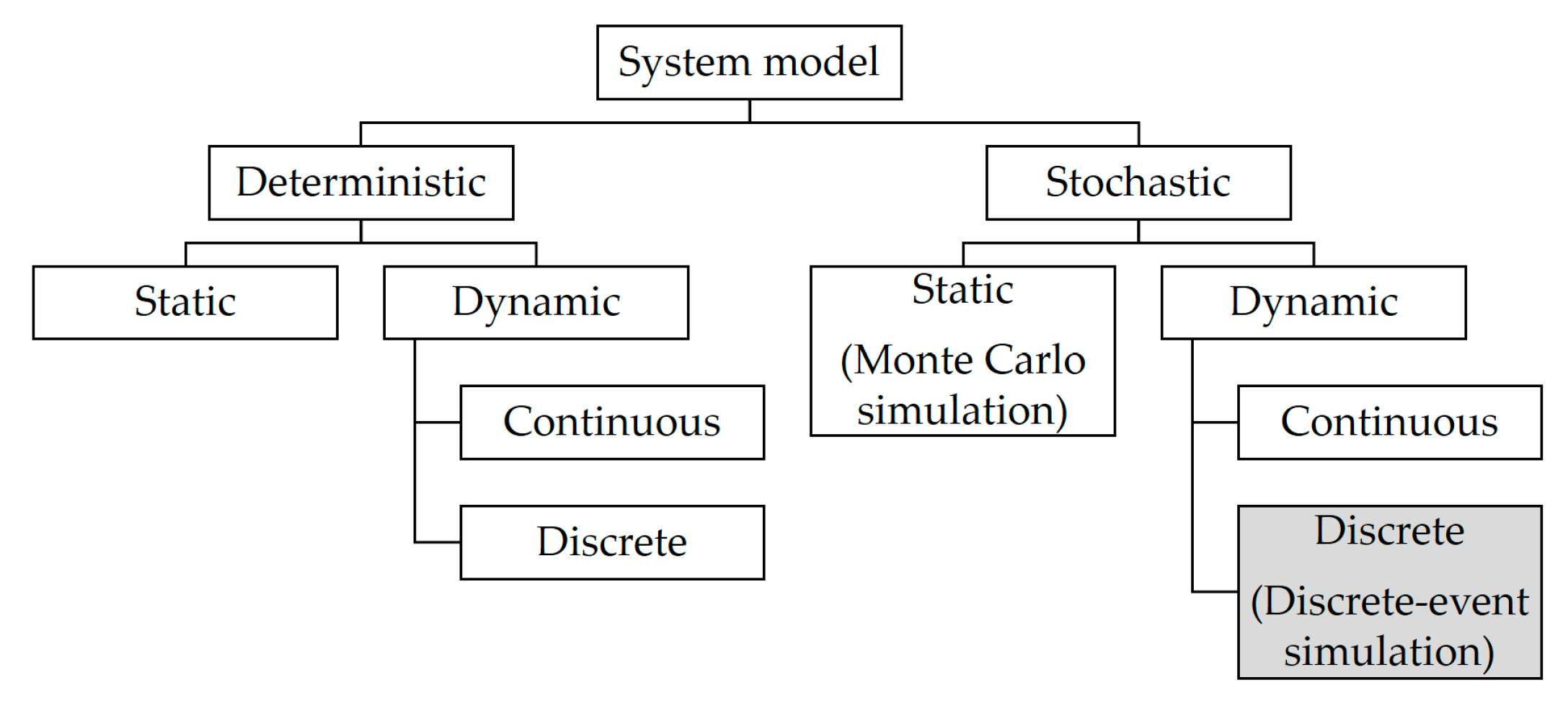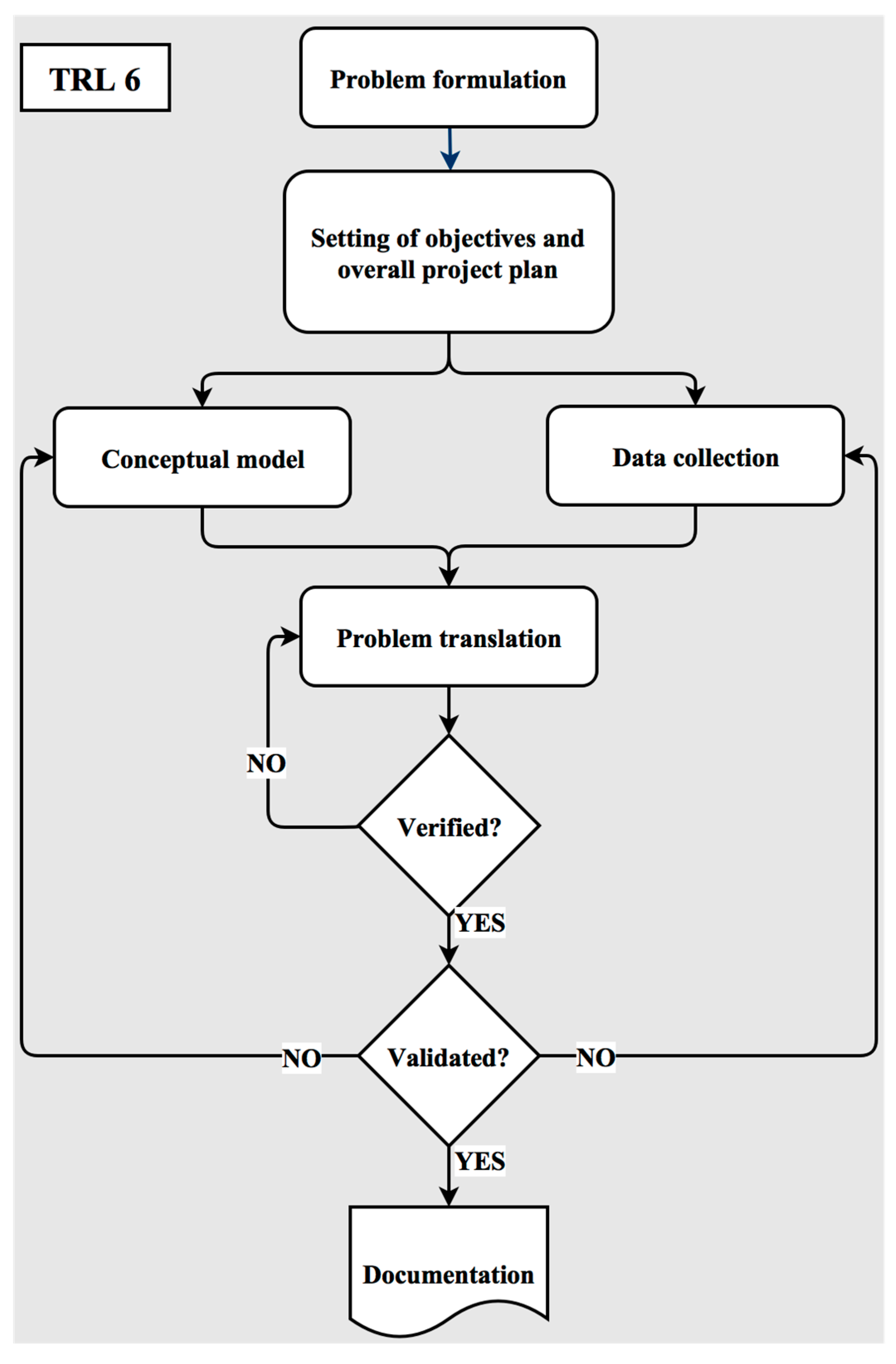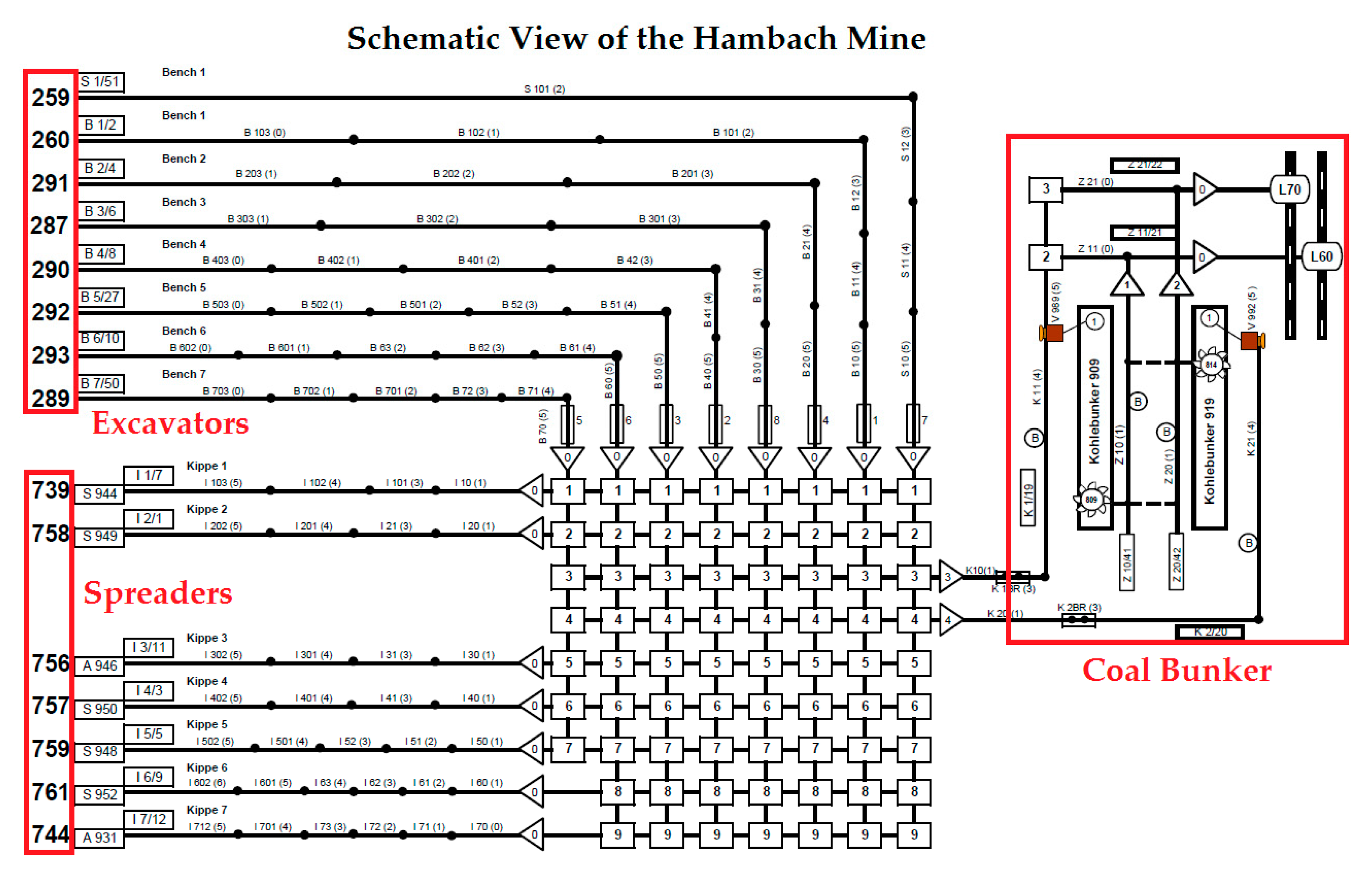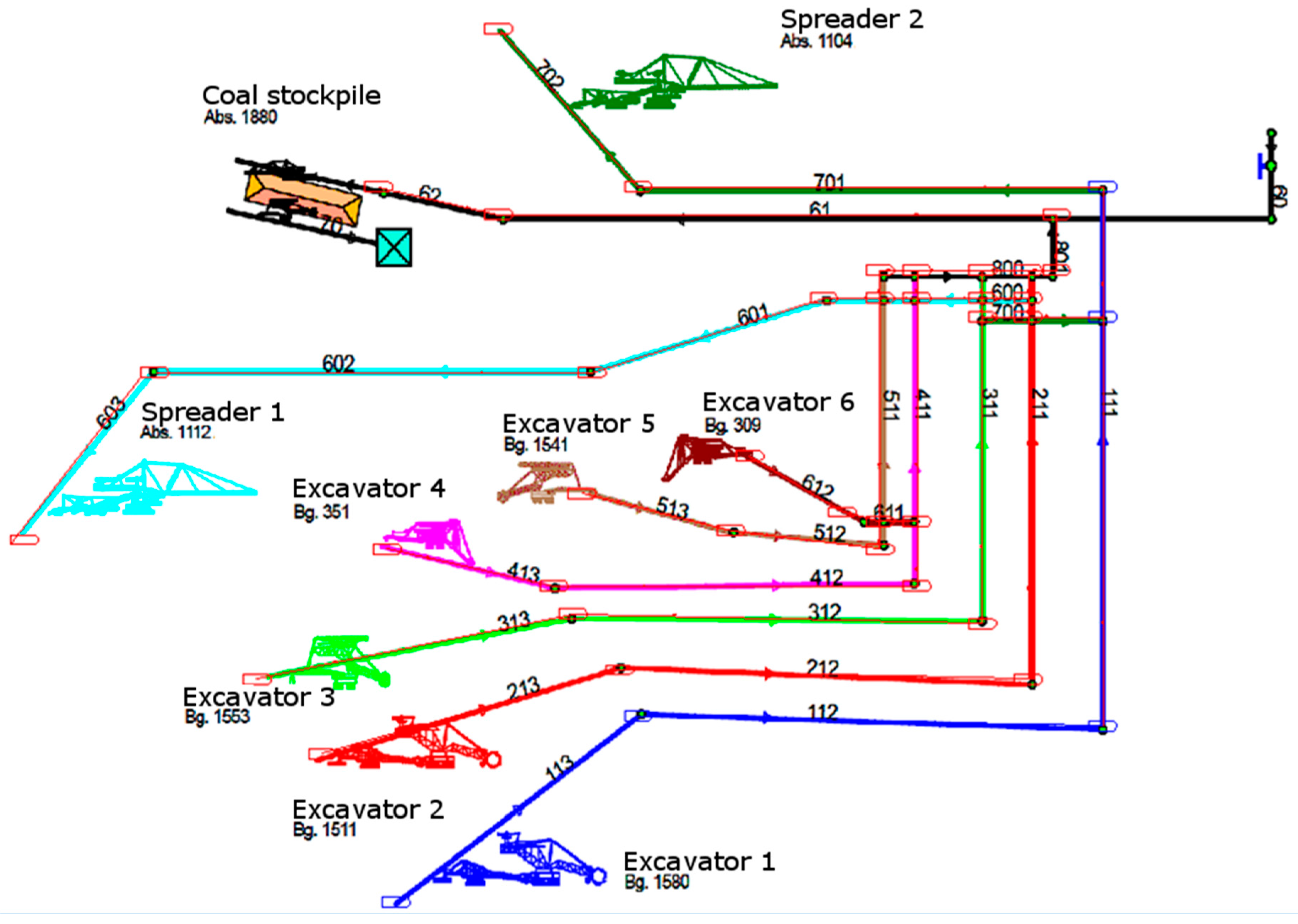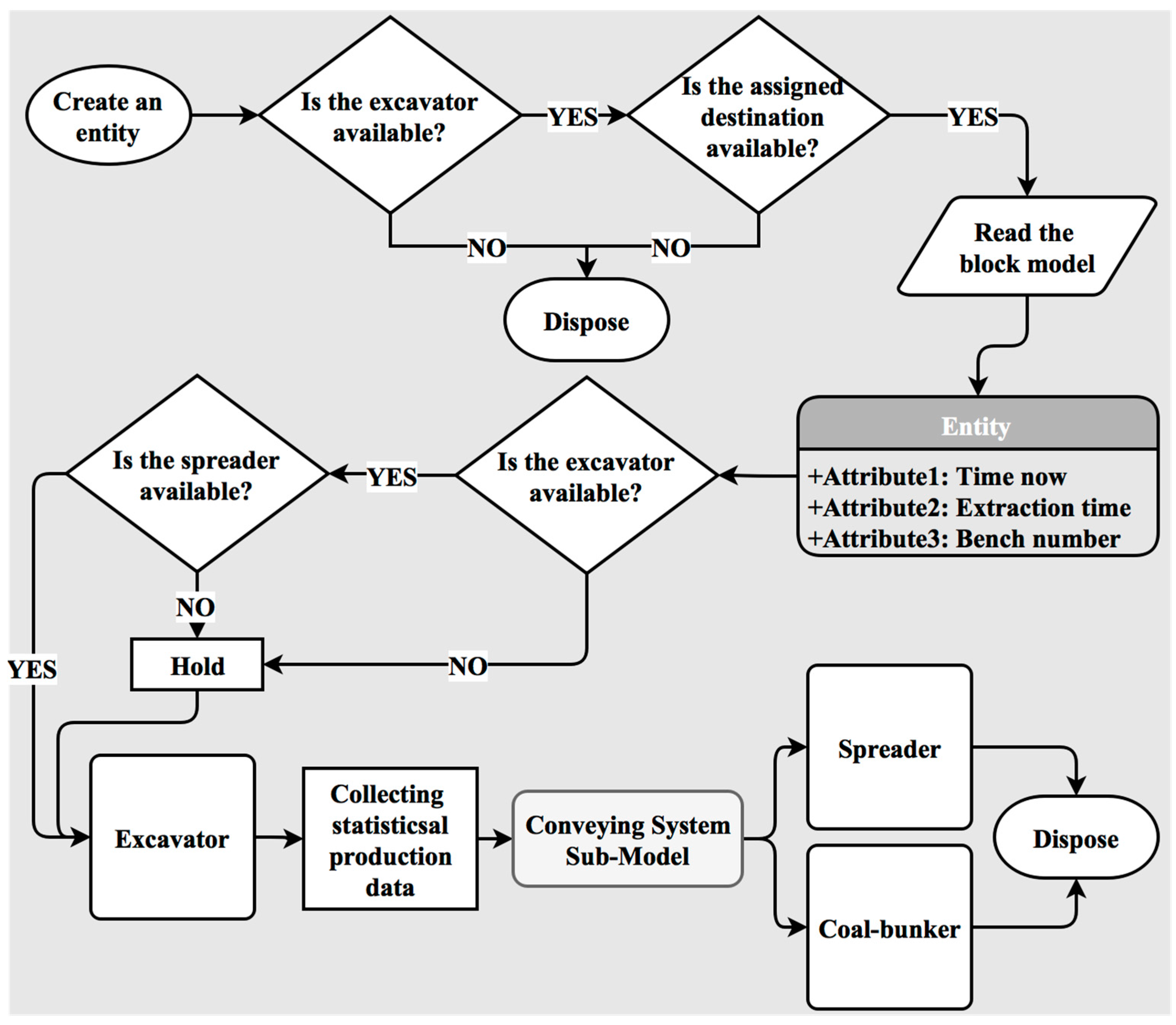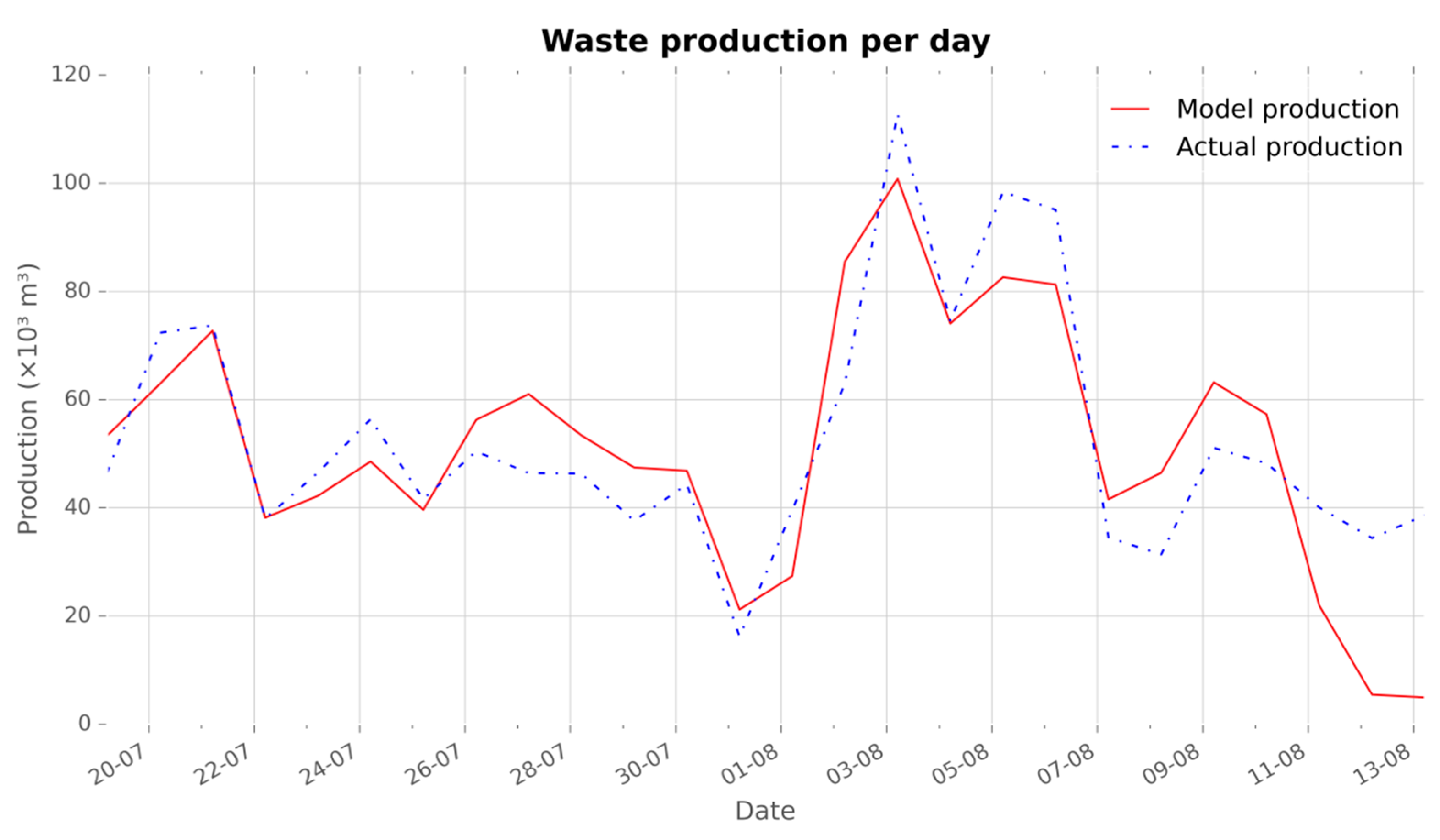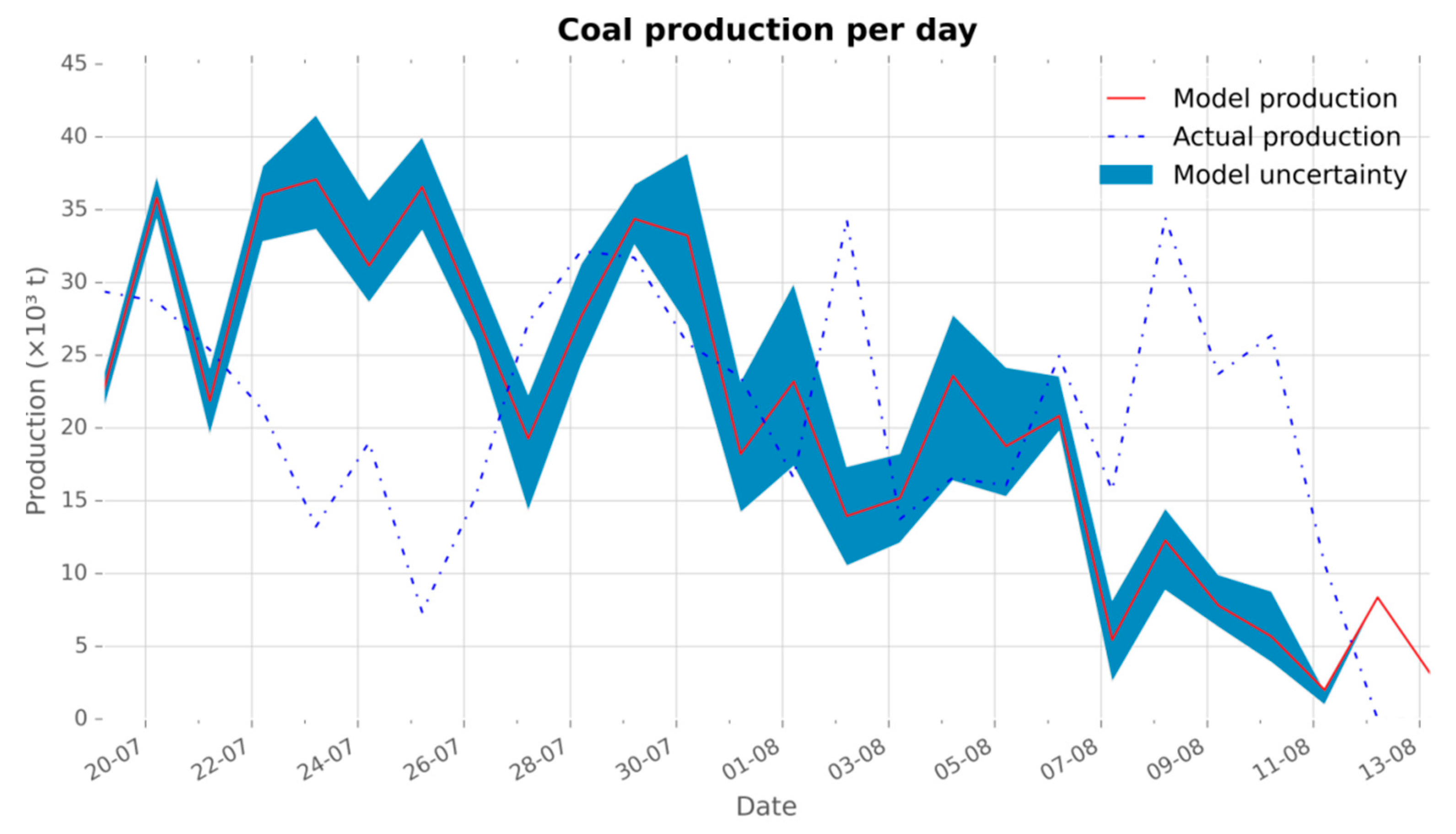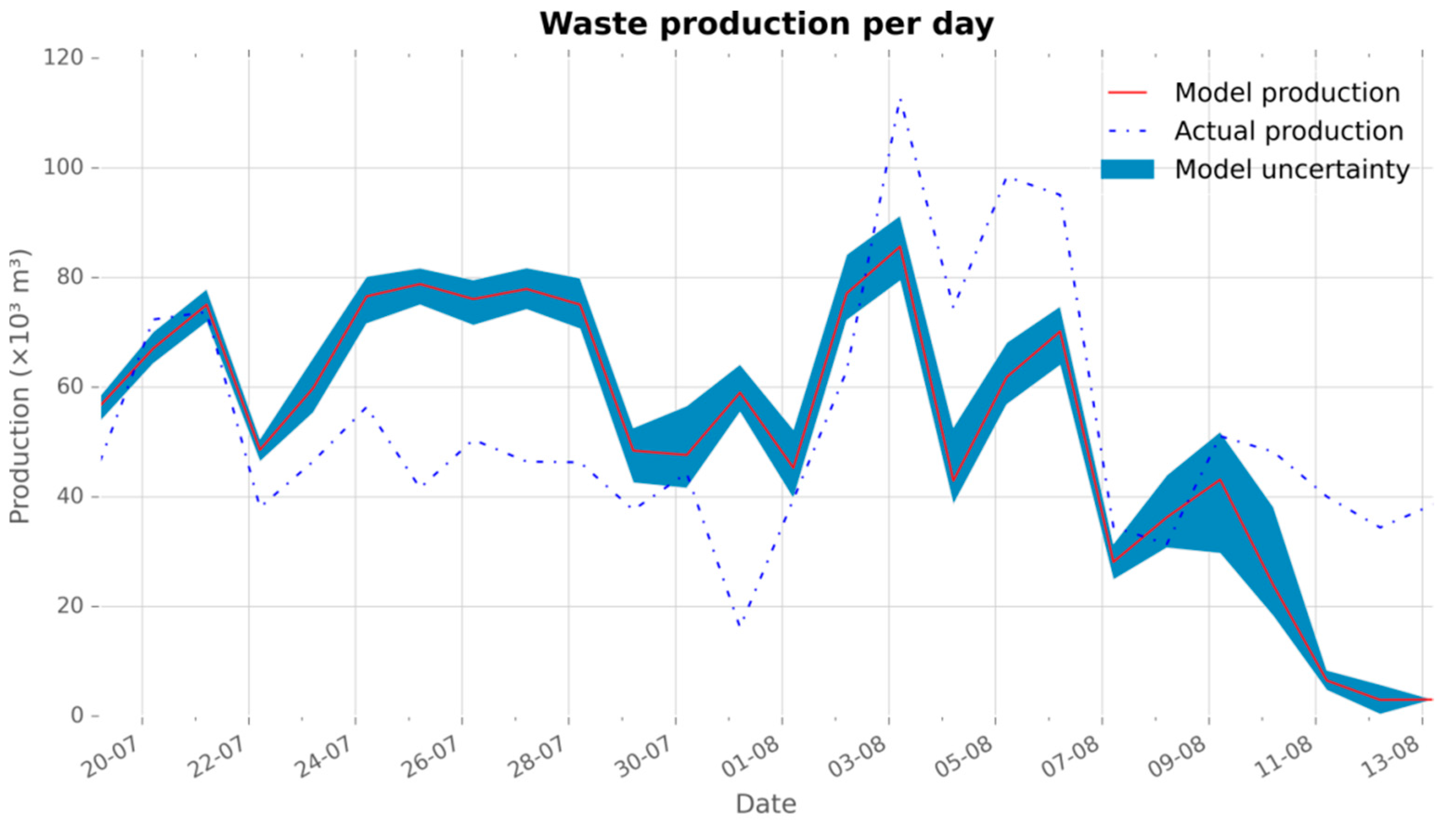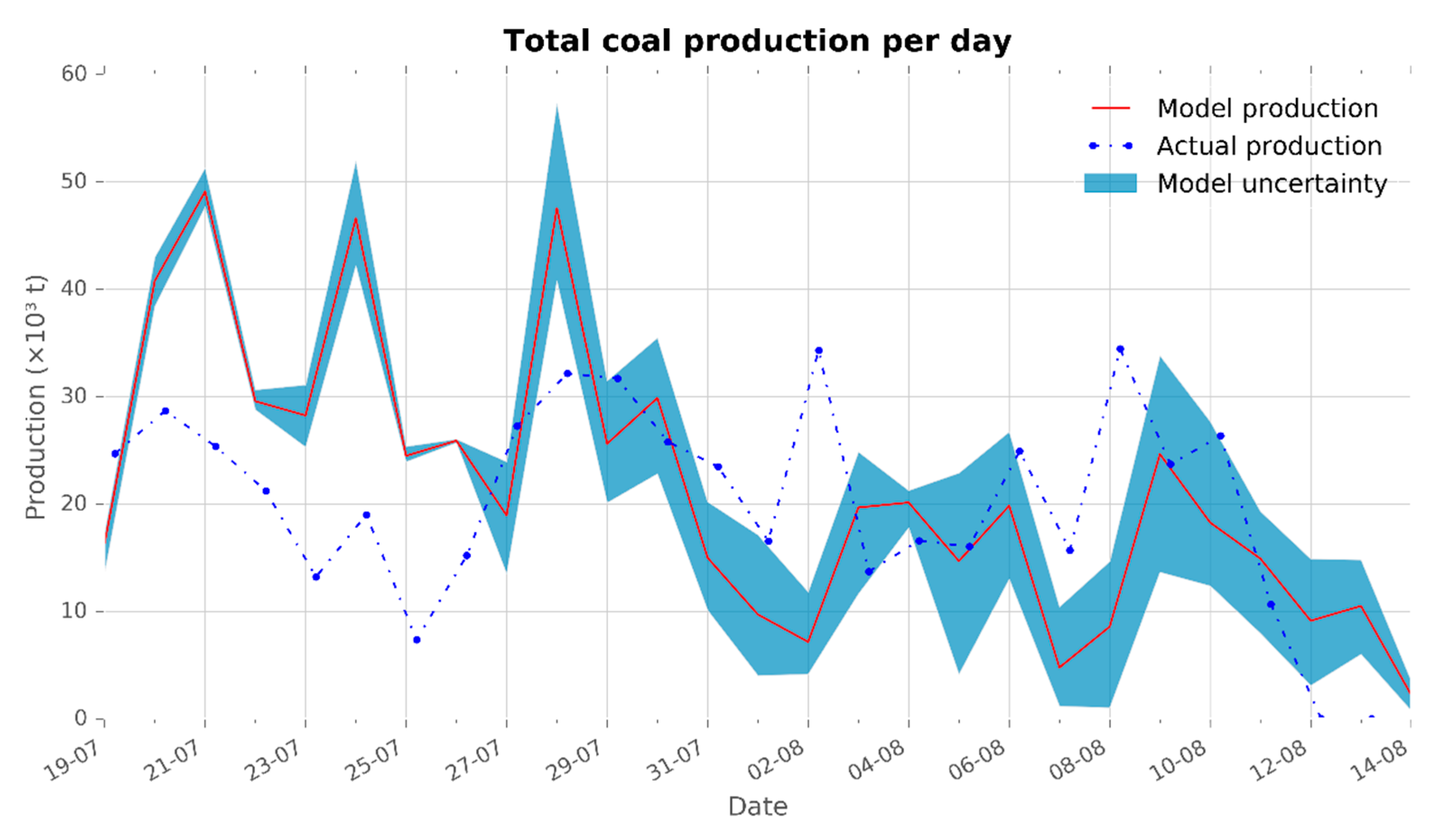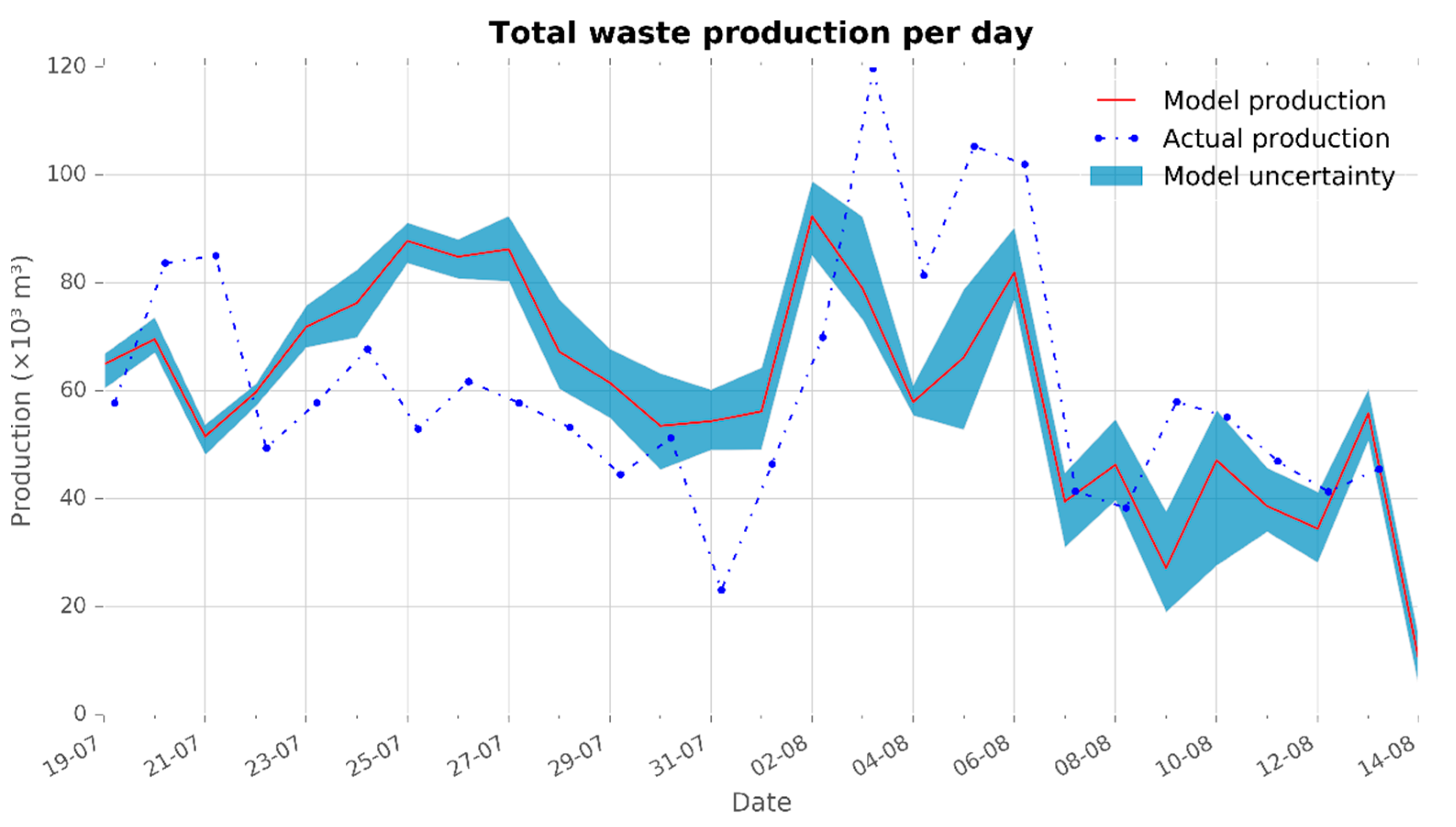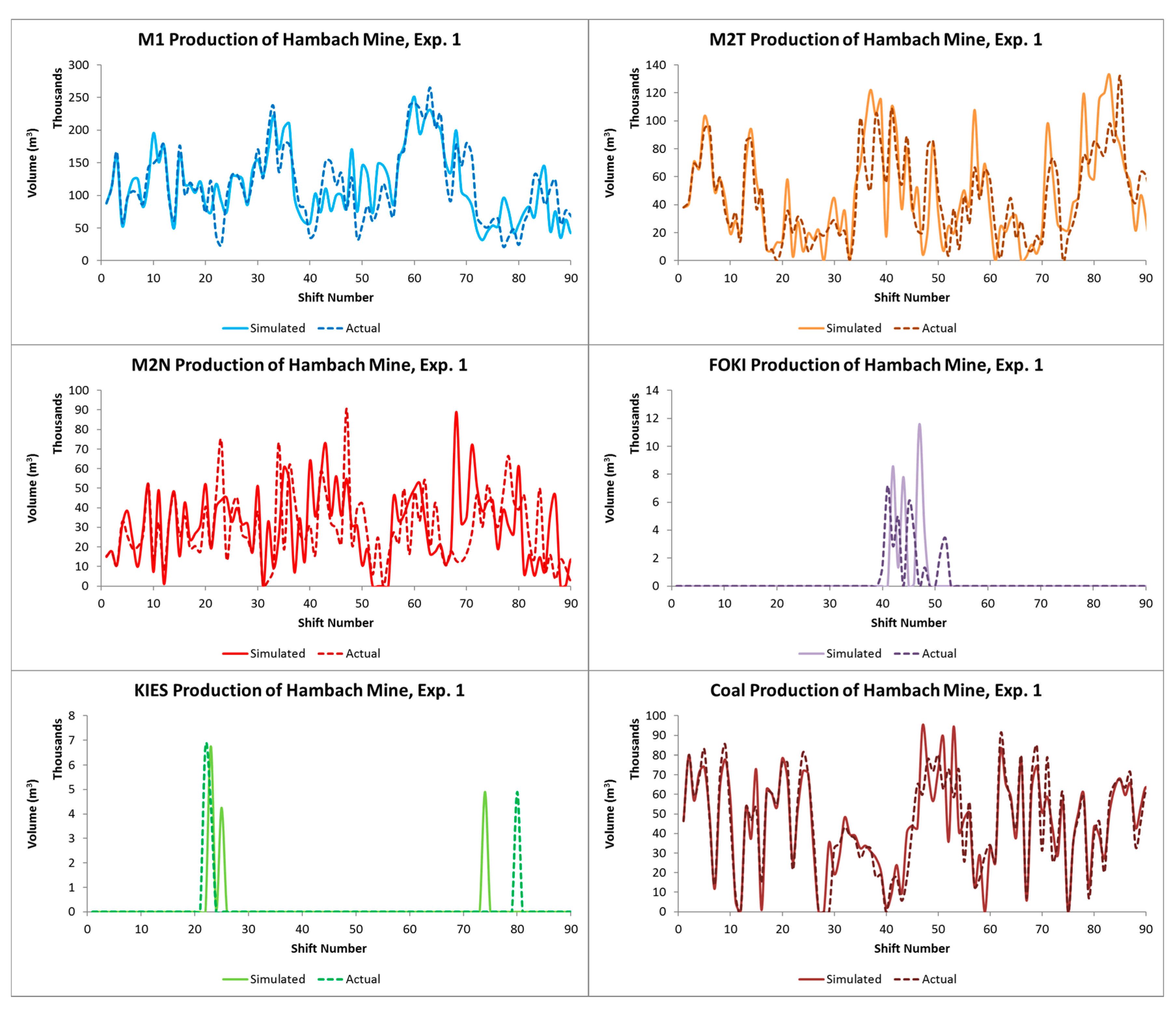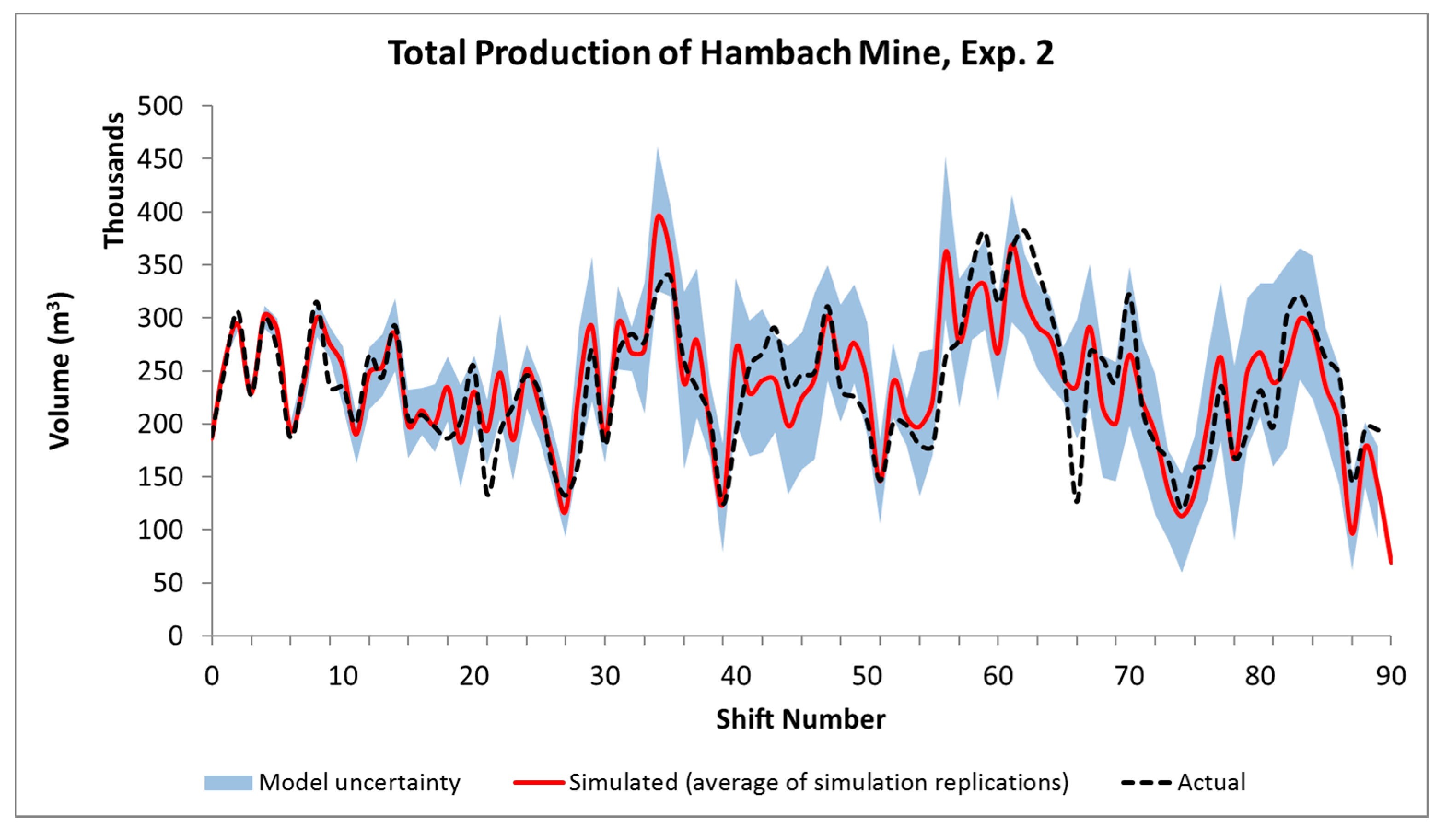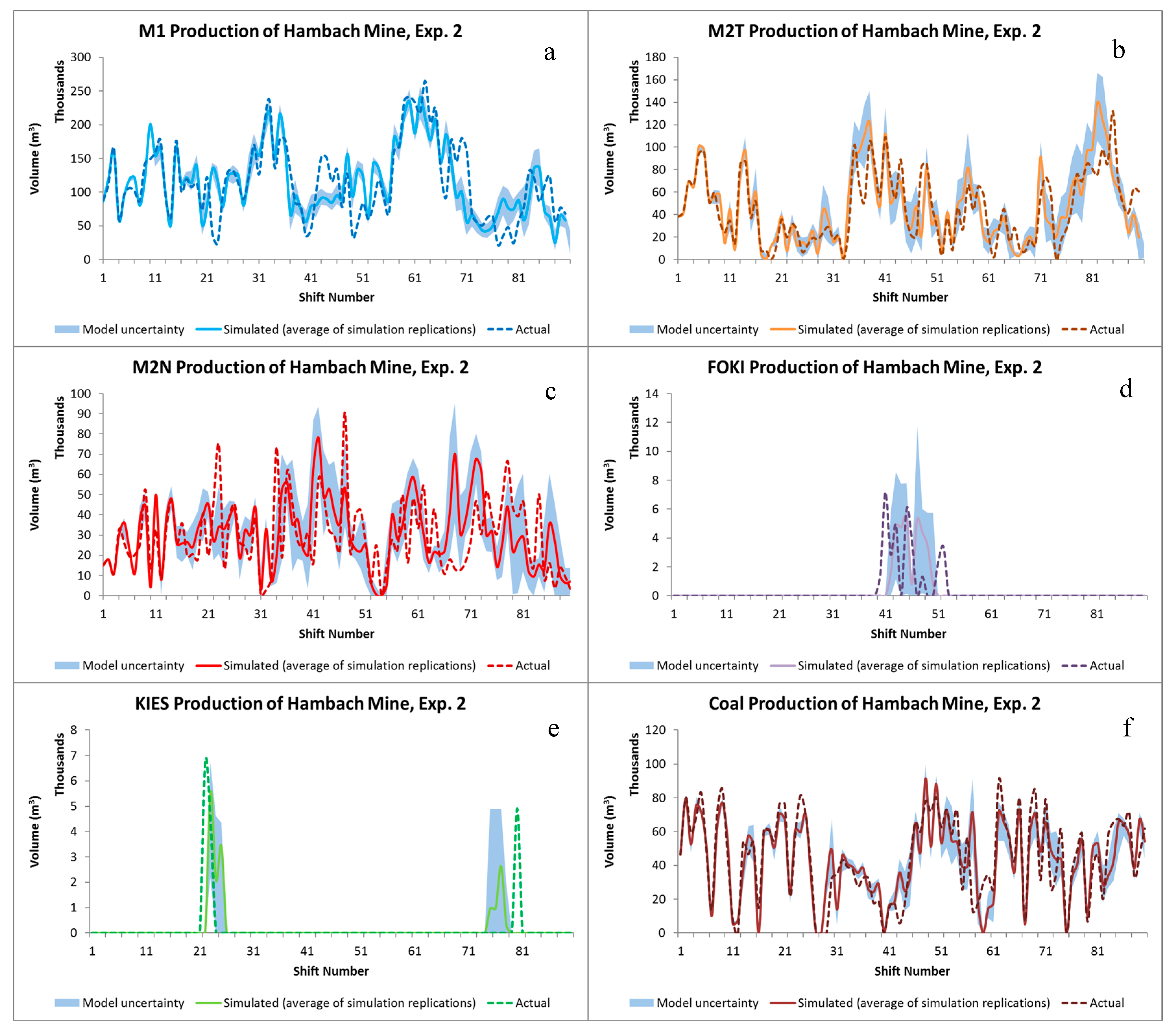Figure 1.
System model taxonomy (reproduced after [
10]).
Figure 1.
System model taxonomy (reproduced after [
10]).
Figure 2.
Steps in a simulation study (reproduced after [
11]).
Figure 2.
Steps in a simulation study (reproduced after [
11]).
Figure 3.
The applied approach for validation process (Reproduced after [
10]).
Figure 3.
The applied approach for validation process (Reproduced after [
10]).
Figure 4.
Schematic overview of the production system of the Hambach mine.
Figure 4.
Schematic overview of the production system of the Hambach mine.
Figure 5.
Schematic overview of the production system in the Profen mine.
Figure 5.
Schematic overview of the production system in the Profen mine.
Figure 6.
Complicated geology in the Profen mine (second bench).
Figure 6.
Complicated geology in the Profen mine (second bench).
Figure 7.
Historical data of ash content of delivered trains to the power plants (provided by Mitteldeutsche Braunkohlengesellschaft mbH (MIBRAG).
Figure 7.
Historical data of ash content of delivered trains to the power plants (provided by Mitteldeutsche Braunkohlengesellschaft mbH (MIBRAG).
Figure 8.
The sub-process of the continuous mining system.
Figure 8.
The sub-process of the continuous mining system.
Figure 9.
Procedure of processing failure input data [
14].
Figure 9.
Procedure of processing failure input data [
14].
Figure 10.
Flowchart of the main logic behind the simulation model.
Figure 10.
Flowchart of the main logic behind the simulation model.
Figure 11.
Simulation platform diagram.
Figure 11.
Simulation platform diagram.
Figure 12.
Comparison of daily production of coal, Experiment 1.
Figure 12.
Comparison of daily production of coal, Experiment 1.
Figure 13.
Comparison of daily production of waste, Experiment 1.
Figure 13.
Comparison of daily production of waste, Experiment 1.
Figure 14.
Comparison of daily production of coal, Experiment 2.
Figure 14.
Comparison of daily production of coal, Experiment 2.
Figure 15.
Comparison of daily production of waste, Experiment 2.
Figure 15.
Comparison of daily production of waste, Experiment 2.
Figure 16.
Daily ash values per day, case Profen.
Figure 16.
Daily ash values per day, case Profen.
Figure 17.
Comparison of daily production of coal, Experiment 3.
Figure 17.
Comparison of daily production of coal, Experiment 3.
Figure 18.
Comparison of daily production of waste, Experiment 3.
Figure 18.
Comparison of daily production of waste, Experiment 3.
Figure 19.
The total shift-based production of the Hambach mine, Experiment 1.
Figure 19.
The total shift-based production of the Hambach mine, Experiment 1.
Figure 20.
The shift-based production of different materials of the Hambach mine, Experiment 1.
Figure 20.
The shift-based production of different materials of the Hambach mine, Experiment 1.
Figure 21.
The total shift-based production of the Hambach mine, Experiment 2.
Figure 21.
The total shift-based production of the Hambach mine, Experiment 2.
Figure 22.
The shift-based production of different materials of the Hambach mine, Experiment 2.
Figure 22.
The shift-based production of different materials of the Hambach mine, Experiment 2.
Figure 23.
Utilization of the equipment in the form of pie charts.
Figure 23.
Utilization of the equipment in the form of pie charts.
Table 1.
Technical specification of BWEs.
Table 1.
Technical specification of BWEs.
| Bench | BWE Model | Discharge Per min | Bucket Capacity (m3) | Theoretical Capacity (m3/h) * |
|---|
| S1 | 259 | 44 | 2.6 | 5700 |
| B1 | 260 | 38 | 3.5 | 5700 |
| B2 | 291 | 48 | 5.0 | 12,500 |
| B3 | 287 | 43 | 5.1 | 10,400 |
| B4 | 290 | 48 | 5.0 | 12,500 |
| B5 | 292 | 48.6–72.0 | 5.0 | 12,500 |
| B6 | 293 | 48.6–72.0 | 5.0 | 12,500 |
| B7 | 289 | 48 | 5.0 | 12,500 |
Table 2.
An overview of the specifications of the equipment.
Table 2.
An overview of the specifications of the equipment.
| Exc. Model | Bench | Access to Abs. 1112 | Access to Abs. 1104 | Access to Coal-bunker | Theoretical Capacity (m3/h) |
|---|
| Bg. 1580 | 1 | No | Yes | No | 4900 |
| Bg. 1511 | 2 | Yes | Yes | Yes | 4900 |
| Bg. 1553 | 3 | Yes | Yes | Yes | 3770 |
| Bg. 351 | 4 | Yes | No | Yes | 1400 |
| Bg. 1541 | 5 | Yes | No | Yes | 3770 |
| Bg. 309 | 6 | Yes | No | Yes | 740 |
| Abs. 1112 | - | - | - | - | 10,000 |
| Abs. 1104 | - | - | - | - | 10,000 |
Table 3.
Coal types and their properties.
Table 3.
Coal types and their properties.
| Coal Type | Ash Content (%) | Calorific Value (MJ/kg) |
|---|
| KK1 | <8.5% (wet ash) | 9.5–10.5 |
| KK2 | <12% (wet ash) | 9.0–11.4 |
| SK | <15% (dry ash) | >24.5 |
Table 4.
The required data for building a simulation model.
Table 4.
The required data for building a simulation model.
| Process Related Data | - (1)
Production targets (Daily/Weekly/Monthly/Yearly)
- (2)
Equipment
- (3)
Production system scheme
- (4)
Stockpiles
Locations and capacities (division in sub piles/packets) Associated conveyor belts Stacker and reclaimer capabilities
- (5)
Sensors
Position and type of measurements Frequency, accuracy, and precision
|
| Elements Related Data (for Each Piece of Equipment) | - (1)
Capacities of Excavators and Spreaders
Effective Theoretical Effective capacity for different material types Failure characteristics (reliability/ availability) Mean time between breakdowns and repair times
- (2)
Conveyor Belts
- (3)
Cycles of equipment
Long cycle: time between two displacement of conveyor belt Block cycle: required time for extracting/filling one block Slice cycle: required time for extracting /filling one slice and getting ready for starting second slice.
- (4)
A complete database of downtimes of the equipment.
|
| Geological Related Data | - (1)
A geological 3D-cell model
|
Table 5.
Summary statistics of simulated and actual production data of the case Profen, Exp. 1.
Table 5.
Summary statistics of simulated and actual production data of the case Profen, Exp. 1.
| Material Type | Simulated | Actual | Difference (%) | Bias (m3 or t) | Average Deviation (m3 or t) | Average Relative Error per Day (%) |
|---|
| Coal (10³ t) * | 533.01 | 533.06 | −0.01 | −0.05 * | 5.02 * | 26.30 |
| Waste (10³ m3) | 1336.28 | 1378.03 | −3.03 | −41.75 | 10.66 | 23.62 |
| Total (10³ m3) | 1794.81 | 1841.56 | −2.54 | −46.74 | 8.49 | 15.25 |
Table 6.
Summary statistics of simulated and actual production data of the case Profen, Exp. 2.
Table 6.
Summary statistics of simulated and actual production data of the case Profen, Exp. 2.
| Material Type | Simulated | Actual | Difference (%) | Bias (m3 or t) | Average Deviation (m3 or t) | Average Relative Error per Day (%) |
|---|
| Coal (10³ t) * | 541.96 | 533.06 | 1.67 | 8.90 * | 10.36 * | 62.55 |
| Waste (10³ m3) | 1373.68 | 1378.03 | −0.32 | −4.34 | 20.19 | 47.22 |
| Total (10³ m3) | 1844.95 | 1841.56 | 0.18 | 3.39 | 24.08 | 40.76 |
Table 7.
Utilization predicted by the simulation model.
Table 7.
Utilization predicted by the simulation model.
| Status | Bg. 1580 | Bg. 1511 | Bg. 1553 | Bg. 351 | Bg. 1541 | Bg. 309 |
|---|
| Busy | 14.3% | 49.8% | 46.1% | 60.5% | 57.8% | 27.6% |
| Failed | 1.0% | 4.7% | 1.7% | 3.7% | 1.1% | 0.6% |
| Idle | - | 7.8% | 37.0% | 3.7% | 8.5% | 7.4% |
| Inactive | 84.7% | 37.7% | 15.3% | 32.3% | 32.5% | 64.5% |
Table 8.
Actual utilization of the system.
Table 8.
Actual utilization of the system.
| Status | Bg. 1580 | Bg. 1511 | Bg. 1553 | Bg. 351 | Bg. 1541 | Bg. 309 |
|---|
| Busy | 11.7% | 54.0% | 44.7% | 55.8% | 56.7% | 28.2% |
| Failed | 2.9% | 6.9% | 40.9% | 10.9% | 14.8% | 7.1% |
| Inactive | 85.4% | 39.1% | 14.4% | 33.3% | 28.5% | 64.6% |
Table 9.
Differences between the actual and model utilization.
Table 9.
Differences between the actual and model utilization.
| Status | Bg. 1580 | Bg. 1511 | Bg. 1553 | Bg. 351 | Bg. 1541 | Bg. 309 |
|---|
| Busy | 2.6% | −4.2% | 1.4% | 4.7% | 1.1% | −0.7% |
| Failed | −1.9% | −2.2% | −39.2% | −7.2% | −13.7% | −6.6% |
| Inactive | −0.7% | −1.4% | 0.8% | −1.0% | 4.1% | −0.2% |
Table 10.
Summary statistics of simulated and actual production data of the case Profen, Exp. 3.
Table 10.
Summary statistics of simulated and actual production data of the case Profen, Exp. 3.
| Material Type | Simulated | Actual | Difference (%) | Bias (m3 or t) | Average Deviation (m3 or t) | Average Relative Error per Day (%) |
|---|
| Coal (10³ t) * | 582.51 | 533.06 | 10.24 | 49.45 * | 12.31 * | 65.90 |
| Waste (10³ m3) | 1402.73 | 1378.03 | 1.54 | 24.7 | 16.33 | 29.29 |
| Total (10³ m3) | 1909.26 | 1841.56 | 3.49 | 67.7 | 18.82 | 24.65 |
Table 11.
Summary statistics of the simulated and the actual production data of the Hambach case, Exp. 1.
Table 11.
Summary statistics of the simulated and the actual production data of the Hambach case, Exp. 1.
| Material Type 1 | Simulated | Actual | Difference (%) | Bias (m3 or t) | Average Deviation per Shift (m3 or t) | Average Relative Error Per Shift (%) |
|---|
| M1 (m³) | 10,604,266 | 10,655,819 | −0.48 | −51,553 | 26,178 | 0.25 |
| M2T (m³) | 4,263,052 | 4,290,314 | −0.64 | −27,262 | 16,965 | 0.40 |
| M2N (m³) | 2,765,828 | 2,765,928 | 0.00 | −100 | 15,050 | 0.54 |
| FOKI (m³) | 33,329 | 33,329 | 0.00 | 0 | 593 | 1.78 |
| KIES (m³) | 16,000 | 16,000 | 0.00 | 0 | 251 | 1.57 |
| Coal (t) | 4,157,393 | 4,183,493 | −0.62 | −26,100 | 7872 | 0.19 |
| Total volume (m³) | 21,297,599 | 21,399,210 | −0.47 | −101,611 | 27,064 | 0.13 |
Table 12.
Summary statistics of the simulated and the actual production data of the Hambach case, Exp. 2.
Table 12.
Summary statistics of the simulated and the actual production data of the Hambach case, Exp. 2.
| Material Type | Simulated | Actual | Difference (%) | Bias (m3 or t) | Average Deviation per Shift (m3 or t) | Average Relative Error per Shift (%) |
|---|
| M1 (m³) | 10,556,753 | 10,655,819 | −0.93 | −99,066 | 27,892 | 0.26 |
| M2T (m³) | 4,257,161 | 4,290,314 | −0.77 | −33,153 | 14,912 | 0.35 |
| M2N (m³) | 4,257,161 | 4,290,314 | −0.77 | −33,153 | 14,610 | 0.34 |
| FOKI (m³) | 33,329 | 33,329 | 0.00 | 0 | 414 | 1.24 |
| KIES (m³) | 16,000 | 16,000 | 0.00 | 0 | 251 | 1.57 |
| Coal (t) | 4,060,603 | 4,183,493 | −2.94 | −122,890 | 9336 | 0.22 |
| Total volume (m³) | 23,181,006 | 23,469,269 | −1.23 | −288,263 | 30,938 | 0.13 |
